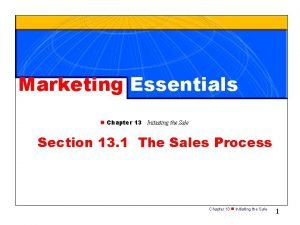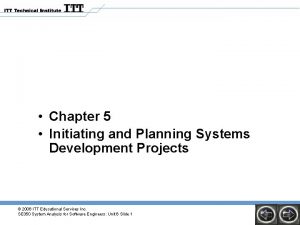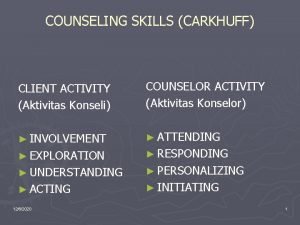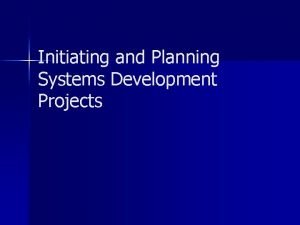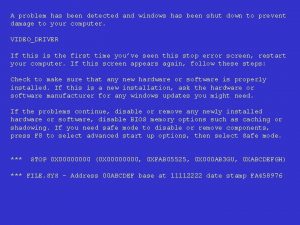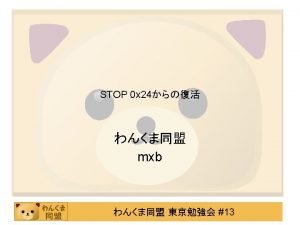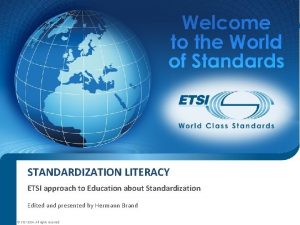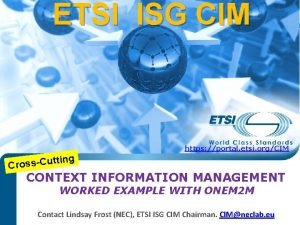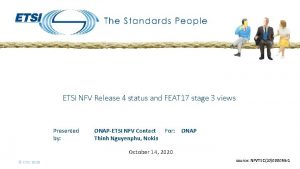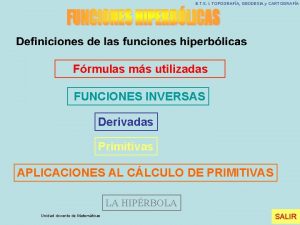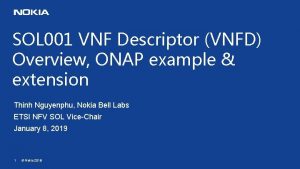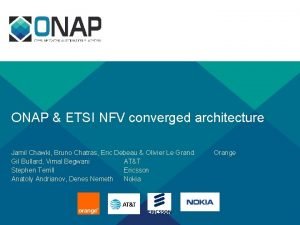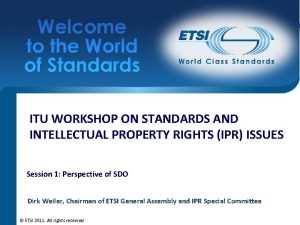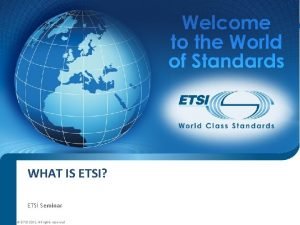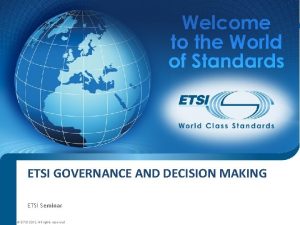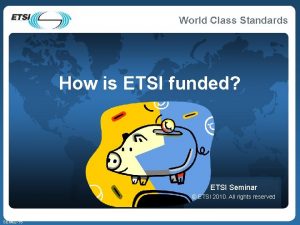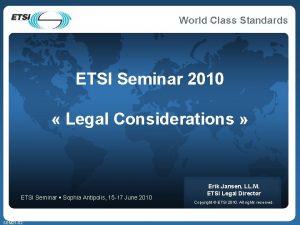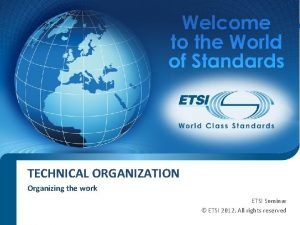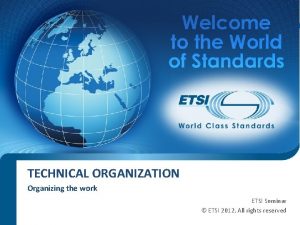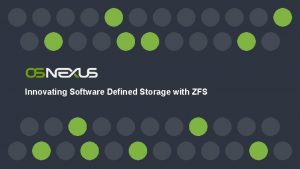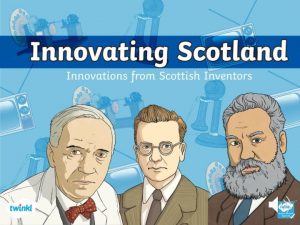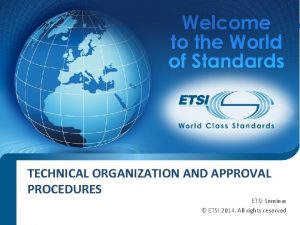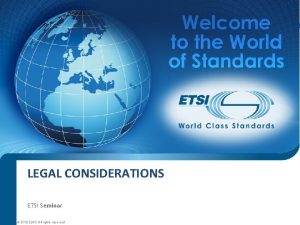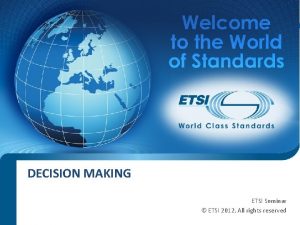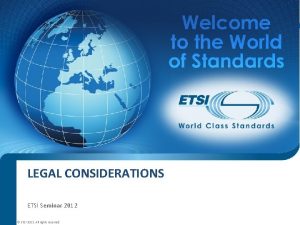INNOVATING IN ETSI INITIATING NEW WORK ETSI Seminar





















- Slides: 21

INNOVATING IN ETSI - INITIATING NEW WORK ETSI Seminar © ETSI 2014. All rights reserved

Agenda A simple innovation model Innovation@ETSI Paths to start new work Examples • New TB • New ISG Summary 2 © ETSI 2014. All rights reserved

Innovation matrix Great! What is our potential % unaided awareness change from converting respondents who are satisfied but not loyal into loyal/ satisfied accounts with a top-ofmind brand promise? New TECHNOLOGY 60%PET / 40%PEN increases the T-sub-G by nearly 10 C. It’s a breakthrough! 2. Technology Driven 1. Incremental 4. Breakthrough 3. Inspired Existing Known Unknown CUSTOMER NEEDS 3 © ETSI 2014. All rights reserved

Innovation@ETSI attract new members start new work in ETSI more and more relevant publications 4 © ETSI 2014. All rights reserved

Meeting the window of opportunity 5 Pre-Standardization Standard Setting Post-Standardization Embryonic stage: q. Technology breeding q. Business nurturing ‘The making of a standard’ Maintenance: q. Corrections q. Incremental feature enhancements Not yet a best solution There is a best solution Enhancements and (at least consensus on a enrichments of the solution) solution Overall system architecture frozen Studies q. Gap analysis q. Assessments of competing solutions q. Roadmapping Technical standards © ETSI 2014. All rights reserved CR and new releases

Feeding the ‘ETSI innovation pipe’ Potential new work Y Technical Body (EP, TC -> PP) N Y Industry Specification Group Y Forum/Consortium (ETSI hosted) N Evolve the ETSI Work Programme 6 © ETSI 2014. All rights reserved

Paths to start new work in ETSI Different levels of innovation in ETSI New WI (new standard), new WG (for new work items) – committee decides New TC, EP – Board decides (New PP – GA decides) New ISG – DG decides (upon Board consultation) 7 © ETSI 2014. All rights reserved

Creation of a Work Item The description of a task defined in terms of the: • title • intended deliverable type (EN, ES, TS, EG, TR) • technical scope • schedule of tasks for its production • identities of the supporting members (minimum 4) • identity of the rapporteur • other aspects (environmental, User and security aspects) separate Work Item for each deliverable TBs define and approve new Work Items. - TWP 1. 6. 1 8 © ETSI 2014. All rights reserved

Adoption of a Work Item into the work program Technical Body completes Work Item form and adopt it using the normal decision making process Work Item on ETSI Work Programme (EWP), flagged “New” • until the end of the month following the month the WI was entered onto the Work Programme ETSI Secretariat makes EWP available to ETSI members Work Item adoption is confirmed unless a substantial objection is received from an ETSI member (Similar arrangements for 3 GPP Work Items) 9 © ETSI 2014. All rights reserved - TWP 1. 6. 3

The rapporteur “individual responsible for an ETSI work item and who acts as the prime contact point on technical matters and for information on progress throughout the drafting phases of the Work Item” Rapporteur’s tools: • ETSI Style Sheet • ETSI Drafting Rules • Document template 10 © ETSI 2014. All rights reserved

How to start a new TC Board strategic topic/ad-hoc group Workshop, meetings as appropriate Draft and agree on scope of work/To. R (Terms of Reference) with minimum support of 4 ETSI members Board creates the TC by approving its To. R based on written proposals in accordance with the criteria given in annex D. (TWP 1. 2) Examples RRS, M 2 M 11 © ETSI 2014. All rights reserved

TWP Annex D: TB general Part A (changes to these items require further approval - see clause 1. 2): a) Terms of Reference and the technical objective(s); b) an analysis concluding that the proposed task is within the ETSI field of interest; c) an analysis stating why any overlapping or complementary elements (with reference to existing work or Terms of Reference of any existing Technical Committee or Project) is regarded as desirable shall be provided; d) a Project Plan; e) the Technical Body shall have selected its Chairman (see clause 1. 3. 1 for details of appointment); f) the total resource requirement shall be estimated and the source of these resources shall be identified; g) any ETSI Secretariat resources required by a Technical Body shall be specified. Part B (changes to these items do not require further approval - see clause 1. 2): a) at least four ETSI full and/or associate members shall have declared their willingness to provide resources; b) the planned deliverables and their delivery dates shall be identified; c) any requirement for Standstill shall be described; d) the internal organization to be used shall be described; e) any committee/project-external ETSI resources required (i. e. outside those provided by the Technical Body participants) shall be specified. Technical Committees can require external resources in the form of a Specialist Task Force or input from another Technical Committee. ETSI Projects and ETSI Partnership Projects can require external resources in the form of a Specialist Task Force or a subcontract with a Technical Committee for a specific task; f) maintenance arrangements for deliverables shall be specified. 12 © ETSI 2014. All rights reserved

How to start a new ISG Draft ISG proposal/To. R with at least 4 ETSI members (so-called founding members) Legal review DG consultation DG submits proposal to Board for consultation DG creates ISG and approves its To. R, based on written proposals in accordance with the criteria given in Annex D. 3. (TWP. 3. 2) Examples: QKD, NFV 13 © ETSI 2014. All rights reserved

TWP Annex D 3: ISGs Part A (changes to these items require further approval - see clause 3. 2): a) Terms of Reference and the technical objective(s) including the expected impact of its results on the Work Programme of the ETSI Technical Organisation; b) an analysis concluding that the proposed task is within the ETSI field of interest; c) an analysis stating why any overlapping or complementary elements (with reference to existing work or Terms of Reference of any existing Technical Committee or Project) is regarded as desirable shall be provided; d) the time plan for work of the group, subject to a maximum initial duration of two years; NOTE On request from the ISG, the Director-General may extended this duration on an annual basis, after a review taking into account the original objectives of the ISG and the advice of the Board, . In order to be extended the ISG shall demonstrate that its results will contribute to the Work Programme of the ETSI Technical Organisation. e) the name of the initial Chairman; f) the total resource requirement shall be estimated and the source of these resources shall be identified; g) any ETSI Secretariat resources required shall be specified. h) the draft Industry Specification Group membership agreement. Note: This should be prepared in co-operation with the ETSI Legal Advisor. Part B (changes to these items do not require further approval - see clause 1. 1): Page 130 ETSI Technical Working Procedures, 19 September 2013 a) at least four ETSI full and/or associate members shall have declared their support and willingness to provide resources; b) the planned deliverables and their delivery dates shall be identified; c) the internal organization to be used shall be described; d) any committee/project-external ETSI resources required (i. e. outside those provided by the Industry Specification Group participants) shall be specified; e) maintenance arrangements for deliverables and/or transition arrangements for the organisation structure shall be specified; f) the relationship with ETSI Technical Organisation shall be specified (i. e. list the interfaces between the ISG and ETSI TBs). 14 © ETSI 2014. All rights reserved

Examples Technology driven (e. g. ISG QKD) vs. business driven (ISG NFV) vs. policy driven (e. g. TC AERO) standardisation Broad technical scope (e. g. TC ERM) versus narrow technical scope (e. g. ISG ECI) Technology oriented standardisation groups provide technical solution elements for a given business context or several business models may exist to capture the value of the technology (e. g. TC RRS exploiting results from FP 6 E 2 R, FP 7 E 2) Business oriented standardisation groups often are forum like initiatives under the umbrella of ETSI. Time to market is crucial. Often pull technological solutions (e. g. ISG NFV (more than 200 companies since January 2013)) 15 © ETSI 2014. All rights reserved

Strong ‘Drafting Committees’ are key Meet the window of opportunity by starting early • Convert existing communities e. g. R&I project consortium into prestandardisation groups Build consensus early to be ready to set a standard • Attract key stakeholders who need the standards to develop their business and support their top experts to progress the work • Build critical mass and grow as you go Strengthen drafting committees through experts in STF NOTE: Enlarge drafting committees • non-ETSI members in ISGs • Members of Organisational Partners in PPs 16 © ETSI 2014. All rights reserved

Thank you for your attention! 17 © ETSI 2014. All rights reserved

How ETSI works – approving European Standards approval Layer 3 Conversion 2 ETSI Standards approval Layer 2 Conversion 1 Group Specifications Technical Specifications/Reports, other deliverables Layer 1 drafting ISGs Layer 1 drafting TCs Member delegates develop deliverables by making written contributions Separation of working level, i. e. drafting of deliverables from adoption of standards Through approval procedures consensus is formally established within different communities of stakeholders (members, NSOs/National Delegations) 18 © ETSI 2014. All rights reserved

How ETSI works - different lines of production ETSI branded – TCs/EPs and ISGs DG Members have to sign an agreement, contracted non-ETSI member participants (bound to IPR Policy) TCs/EPs Board Members only (Guests on a temporary and exceptional basis without the right to make technical contributions because they are not bound to IPR policy) Voting Project specific (usually one member one vote) Weighted voting Fees Participation fee per meeting for non-member participants Annual membership fee IPR Policy FRAND Decision power Participation Non-ETSI branded (own identity) • Partnership Projects (PPs) • Joint membership of organizational partners • Joint technical work (drafting and adoption of specifications) • Coordinated adoption by organizational partners in EU, US, Japan, South Korea, China • Forapolis services fora/consortia (ETSI inside), e. g. 19 © ETSI 2014. All rights reserved

ICT penetrates all sectors business smart transportation, smart energy grids, manufacturing , consumer smart buildings, . . . interactive digital media 1. 2. 3. 4. 5. 20 © ETSI 2014. All rights reserved societ e. Health, y e. Education, . . . (common) ICT infrastructu re/ enablers converged communicatio n, information, entertainment Commoditisation and substitution of telephony Accelerated market segmentation Lack of shared vision and overall architecture Competing alternative technical approaches Larger and more complex cross-sector eco-systems

Checklist of Essential Success Factors External Is the objective of the TB to develop standards for a new or leading edge technology? Will the products and services incorporating the standard offer identified benefits and beneficiaries? Is there an identified market for these products and services (either high value or high volume and potentially global)? Internal Is there evidence that stakeholders want common (preferably global) standards and are they willing to develop these in ETSI? Are stakeholders engaged that have a strong interest to deploy products and services incorporating these standards? Are stakeholders from the whole cross-sector ecosystem (covering a critical mass of the value chain) engaged and committed to the activity? 21 © ETSI 2014. All rights reserved
 Innovating for people
Innovating for people Merchandise approach method
Merchandise approach method Responding sides
Responding sides Initiating and planning systems development projects
Initiating and planning systems development projects User requirement
User requirement Experimenting relationship stage
Experimenting relationship stage Attending responding personalizing initiating
Attending responding personalizing initiating Initiating and planning systems development projects
Initiating and planning systems development projects What are the leadership challenges for the youth of today
What are the leadership challenges for the youth of today Initiating process group
Initiating process group A problem has been detected and windows xp
A problem has been detected and windows xp A problem was detected and windows was shut down
A problem was detected and windows was shut down Etsi - ict standards
Etsi - ict standards Www.etsi.org
Www.etsi.org Portal etsi
Portal etsi Etsi membership
Etsi membership What is etsi
What is etsi Etsi nfv release 4
Etsi nfv release 4 Etsi topografia
Etsi topografia Vnf descriptor
Vnf descriptor Etsi mano architecture
Etsi mano architecture Etsi ipr database
Etsi ipr database

